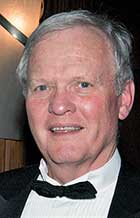 Dr. Richard McCoy, a native of Palouse, Wash., has been a part of our School for 60 years, both as a student and faculty member. He arrived in 1957 a country boy well versed in fishing, an activity he enjoys to this day. He learned dentistry from the renowned Drs. Gerald Stibbs, Ken Morrison, and Myron Warnick, to name a few, and he credits them with shaping his distinguished career. After graduation in 1961, Dr. McCoy served his obligatory two years of military service at the U.S. Naval Air Station in Kodiak, Alaska before returning to private practice in Burlington, Wash. Three years later, he returned to active duty in the Navy, where he served until his retirement in 1988. His Navy career included earning his MS degree in Applied Gnathology from Loma Linda University, a tour of duty as Commanding Officer of the Navy Dental Command in Jacksonville, Fla., and as the Director of the Operative Department at the U.S. Naval Graduate Dental School at Bethesda, Md. After leaving the Navy, he joined the faculty at Northwestern University Dental School, where he served as Professor and Chair of the Department of Restorative Dentistry. Dr. McCoy returned to the UW in 1992 and has served as Chair of the Restorative Department and taught Operative Dentistry, Dental Anatomy and Occlusion. The Academy of Operative Dentistry presented him an Award of Excellence in 2001, and our School has recognized him with Distinguished Alumnus and Rothwell Lifetime Achievement in Teaching awards. Even though he officially retired in 2006, he immediately assumed a key role on the Regional Initiatives in Dental Education (RIDE) faculty in Spokane, where he lives with his wife, Erlys. Here he recalls his memories of dental school.
Dr. Richard McCoy, a native of Palouse, Wash., has been a part of our School for 60 years, both as a student and faculty member. He arrived in 1957 a country boy well versed in fishing, an activity he enjoys to this day. He learned dentistry from the renowned Drs. Gerald Stibbs, Ken Morrison, and Myron Warnick, to name a few, and he credits them with shaping his distinguished career. After graduation in 1961, Dr. McCoy served his obligatory two years of military service at the U.S. Naval Air Station in Kodiak, Alaska before returning to private practice in Burlington, Wash. Three years later, he returned to active duty in the Navy, where he served until his retirement in 1988. His Navy career included earning his MS degree in Applied Gnathology from Loma Linda University, a tour of duty as Commanding Officer of the Navy Dental Command in Jacksonville, Fla., and as the Director of the Operative Department at the U.S. Naval Graduate Dental School at Bethesda, Md. After leaving the Navy, he joined the faculty at Northwestern University Dental School, where he served as Professor and Chair of the Department of Restorative Dentistry. Dr. McCoy returned to the UW in 1992 and has served as Chair of the Restorative Department and taught Operative Dentistry, Dental Anatomy and Occlusion. The Academy of Operative Dentistry presented him an Award of Excellence in 2001, and our School has recognized him with Distinguished Alumnus and Rothwell Lifetime Achievement in Teaching awards. Even though he officially retired in 2006, he immediately assumed a key role on the Regional Initiatives in Dental Education (RIDE) faculty in Spokane, where he lives with his wife, Erlys. Here he recalls his memories of dental school.
I began dental school with 74 classmates, but by the end of the first semester we were down to 57. At that time, Dr. [Gerald] Stibbs directed two courses that first semester. He didn’t play games and many couldn’t cut it. My goal, particularly early on, was to remain anonymous. Dr. Warnick, another of my instructors, scoured old yearbooks looking for me when I returned to teach many years later. He said to me, “For the life of me, I cannot remember you in my class.” Mission accomplished! If they didn’t know I was there, I’d stayed out of trouble.
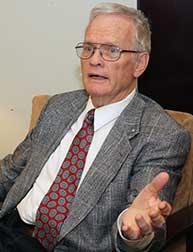 I had excellent instructors. Restorative dominated our time, and Drs. Morrison and Warnick, real sticklers for attention to detail and making sure patients were comfortable, made a huge impression on me. All of the instructors were dedicated to working closely with the students, particularly since everything then was slow speed. Dr. Stibbs held Saturday seminars where we performed gold foil restorations on patients, and he’d have his top instructors with us. At the end of a session, he’d critique our work. I can remember him saying, “McCoy, I don’t know how your work turns out so acceptable when your rubber dam is so poorly done.” I was wise enough to just smile, saying nothing in response.
I had excellent instructors. Restorative dominated our time, and Drs. Morrison and Warnick, real sticklers for attention to detail and making sure patients were comfortable, made a huge impression on me. All of the instructors were dedicated to working closely with the students, particularly since everything then was slow speed. Dr. Stibbs held Saturday seminars where we performed gold foil restorations on patients, and he’d have his top instructors with us. At the end of a session, he’d critique our work. I can remember him saying, “McCoy, I don’t know how your work turns out so acceptable when your rubber dam is so poorly done.” I was wise enough to just smile, saying nothing in response.
The School installed high-speed hand pieces in our clinic during my last semester. They were quite selective on which instructors could teach high-speed technique, and only certain students were allowed to use it. Even a slight misstep could be deadly. One of my classmates was working with high speed on a lower front tooth in preparation for a crown, and he cut the whole tooth off, leaving nothing for a crown. I recall thinking, “Now I know why they don’t let the rest of us do that.”
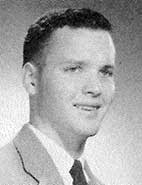
Working with patients while in training taught me early lessons that shaped my career. I still remember my first removable patient. She didn’t have maxillary molars, so we were making her a partial denture. I cut preps on the two pre-molars, so we could put just the right amount of undercut on the abutment crowns to insure adequate retention. I should have remembered that I needed to mix the cement slowly to allow the exothermic reaction to occur without accelerating the set of the zinc phosphate cement so that the setting temperature would be bearable for the patient. But I was so excited when Dr. Morrison said, “Go ahead and cement them.” And I didn’t need to use anesthesia because there wasn’t cutting, just gluing. I mixed up the zinc phosphate cement, put it in each crown, and seated the crowns. I told the patient to bite down on cotton rolls to keep pressure on the crowns until the cement was set. Turns out I’d mixed the cement too fast, causing a hyperthermic reaction, and it was getting hotter as she tried to hold the bite – while screaming. She jumped out of the chair and took off around the clinic with me in pursuit yelling, “Don’t let go! Keep biting!” After about four rounds, she calmed down. Even Dr. Stibbs was speechless. Despite the experience, she’s the only patient that ever thanked me with a cherry pie. The confidence she showed in me meant more to me than anything I ever did that was right.
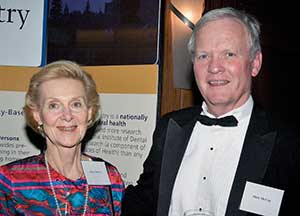
While in school I started dating my future wife. I recall needing a gold credit, and she agreed to let me replace her amalgams with gold restorations. I started with a crown on a maxillary molar. After all the preparatory work had been completed and permission to seat the crown had been received, I was preparing to mix the zinc phosphate for cementation when she started to ask me a question. Suddenly the crown which I had left on the preparation was gone. She had swallowed it. So all sorts of different lessons are possible during dental school.
As Chair of the Restorative Department and an instructor, I was most proud of our students understanding why a tooth is shaped like a tooth. They learned the mechanics of a patient’s bite and what they needed to know to solve problems. I’d tell them, “The quickest way to build a practice is to understand a patient’s chief complaint and to fix it in a timely manner.” Our students were absolutely forbidden to repeatedly ask a patient, “How does it feel now?” A patient shouldn’t do the work for the student, and only when the operator is satisfied that the occlusion is correct should he or she ask the patient how it feels.
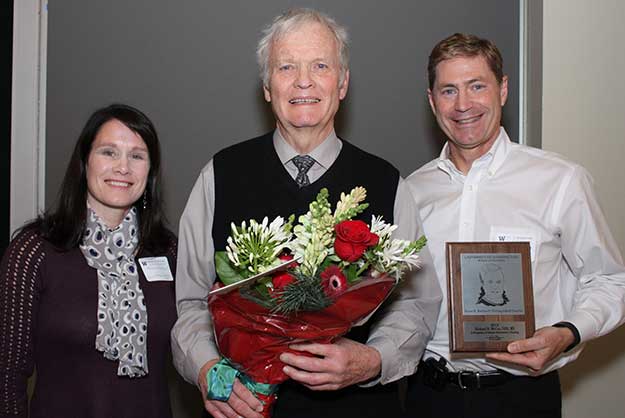
Excellence is a thread running through the history of our School. While in the Navy, I served as an assignments officer, putting brand-new dentists in clinics around the world. There were a lot of independent-duty small dental facilities with one or two dentists in remote postings – in Alaska, for example. The dentists assigned to those places need the ability to function alone. I quickly learned that when looking for someone to fill those positions, I would look for UW graduates because those students were better ready to work independently than students from any other school in the country. Graduates left the UW ready to handle stress. In my day, Dr. Stibbs made sure of that.